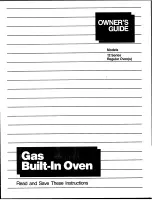
• Do not put the objects directly on the
appliance floor and do not put alumini-
um foil on the components when you
cook. This can change the baking re-
sults and cause damage to the enamel.
11.2
Baking cakes
• Do not open the oven door before 3/4
of the set cooking time is up.
• If you use two baking trays at the same
time, keep one empty level between
them.
11.3
Cooking meat and fish
• Use a deep pan for very fatty food to
prevent the oven from stains that can
be permanent.
• Leave the meat for approximately 15
minutes before carving so that the juice
does not seep out.
• To prevent too much smoke in the oven
during roasting, add some water into
the deep pan. To prevent the smoke
condensation, add water each time af-
ter it dries up.
11.4
Cooking times
Cooking times depend on the type of
food, its consistency, and volume.
Initially, monitor the performance when
you cook. Find the best settings (heat set-
ting, cooking time, etc.) for your cook-
ware, recipes and quantities when you
use this appliance.
11.5
Baking and roasting table
CAKES
TYPE OF
DISH
Conventional
Cooking
True Fan Cook-
ing
Cooking
time
[min]
Notes
Shelf po-
sition
Temp
[°C]
Shelf po-
sition
Tem
p
[°C]
Whisked
recipes
2
170
3 (1 and 4)
160
45 - 60
In a cake
mould
Shortbread
dough
2
170
3 (1 and 4)
160
20 - 30
In a cake
mould
Buttermilk
cheesecake
1
170
2
165
60 - 80
In a 26 cm
cake mould
Apple cake
(Apple pie)
2
170
1 (left and
right)
160
80 - 100
In two 20
cm cake
moulds on a
wire shelf
1)
Strudel
3
175
2
150
60 - 80
In a baking
tray
Jam-tart
2
170
2 (left and
right)
165
30 - 40
In a 26 cm
cake mould
Sponge
cake
2
170
2
160
50 - 60
In a 26 cm
cake mould
Christmas
cake / Rich
fruit cake
2
160
1 or 2
140
–
150
90 - 120
In a 20 cm
cake
mould
1)
18 www.electrolux.com
















































